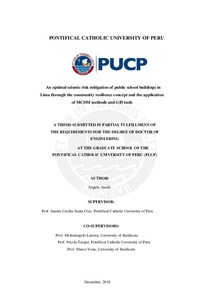| dc.contributor.advisor | Santa Cruz, Sandra Cecilia | |
| dc.contributor.advisor | Laterza, Michelangelo | |
| dc.contributor.advisor | Tarque, Nicola | |
| dc.contributor.advisor | Vona, Marco | |
| dc.contributor.author | Anelli, Angelo | |
| dc.date.accessioned | 2019-02-25T17:03:16Z | |
| dc.date.available | 2019-02-25T17:03:16Z | |
| dc.date.created | 2018 | |
| dc.date.issued | 2019-02-25 | |
| dc.identifier.uri | http://hdl.handle.net/20.500.12404/13545 | |
| dc.description.abstract | Nowadays retrofitting strategies are a typical problem of public administrations. Due to the amount of essential and/or historic buildings that require seismic retrofitting and the restricted economic availability, it is necessary to prioritize interventions on a large territorial scale in order to optimize the allocation of available economic resources, provide transparent guidelines, and identify the best solution with an integrated view of the problem.
In this thesis work, a prioritization methodology for seismic risk reduction in public schools is developed. The suggested methodology is based on the community resilience concept, Multi-Criteria Decision-Making (MCDM) methods, and Geographic Information Systems (GIS). It allows to define a proactive and resilient seismic risk mitigation strategy with a geographical, multidisciplinary, and multidimensional perspective. In order to illustrate the proposed methodology, prioritization strategies of retrofit interventions for 1825 public schools in the Lima Metropolitan Area are analyzed. The resilience of the communities has played a key role in the definition of the seismic risk mitigation policies. Three perceptions are identified to use the resilience concept in the present thesis work: seismic risk, emergency management, integration and social cohesion. They represent groups of interwoven technical, organizational, social, and economic dimensions. Based on these aspects, quantitative and qualitative prioritization criteria are selected and analyzed separately using GIS tools in order to model the schools seismic risk components and quantify the spatial and territorial relationships between schools and their surroundings. Through the assignment of criteria weights, numerous political scenarios are defined to perform predictive analysis that consider the possible uncertainties involved in planning and to enrich the decision-making process with more useful information. In order to compare them and identify the most optimal political scenario, a cost-benefit index and an innovative resilience indicator are determined for each one.
A new and transparent framework is developed to help decision makers in selecting the political strategies, the relative prioritizations of interventions, and their intervention options in the pre- disaster and post-disaster phases. It provides a simplified methodology with solid technical and scientific bases that aims to optimize community resilience using a multidimensional and
xviii
spatiotemporal measurement. Decision makers and engineering professionals could use it as a decision support in the prevention and management of various natural and artificial threats. | es_ES |
| dc.language.iso | eng | es_ES |
| dc.publisher | Pontificia Universidad Católica del Perú | es_ES |
| dc.rights | info:eu-repo/semantics/closedAccess | es_ES |
| dc.subject | Construcciones antisísmicas--Evaluación | es_ES |
| dc.subject | Construcciones escolares--Construcciones antisísmicas | es_ES |
| dc.subject | Análisis estructural (Ingeniería) | es_ES |
| dc.subject | Ingeniería antisísmica | es_ES |
| dc.title | An optimal seismic risk mitigation of public school buildings in Lima through the community resilience concept and the application of MCDM methods and GIS tools | es_ES |
| dc.type | info:eu-repo/semantics/doctoralThesis | es_ES |
| thesis.degree.name | Doctor en Ingeniería | es_ES |
| thesis.degree.level | Doctorado | es_ES |
| thesis.degree.grantor | Pontificia Universidad Católica del Perú. Escuela de Posgrado | es_ES |
| thesis.degree.discipline | Ingeniería | es_ES |
| renati.discipline | 732028 | es_ES |
| renati.level | https://purl.org/pe-repo/renati/level#doctor | es_ES |
| renati.type | http://purl.org/pe-repo/renati/type#tesis | es_ES |
| dc.publisher.country | PE | |
| dc.subject.ocde | https://purl.org/pe-repo/ocde/ford#2.01.01 | es_ES |





